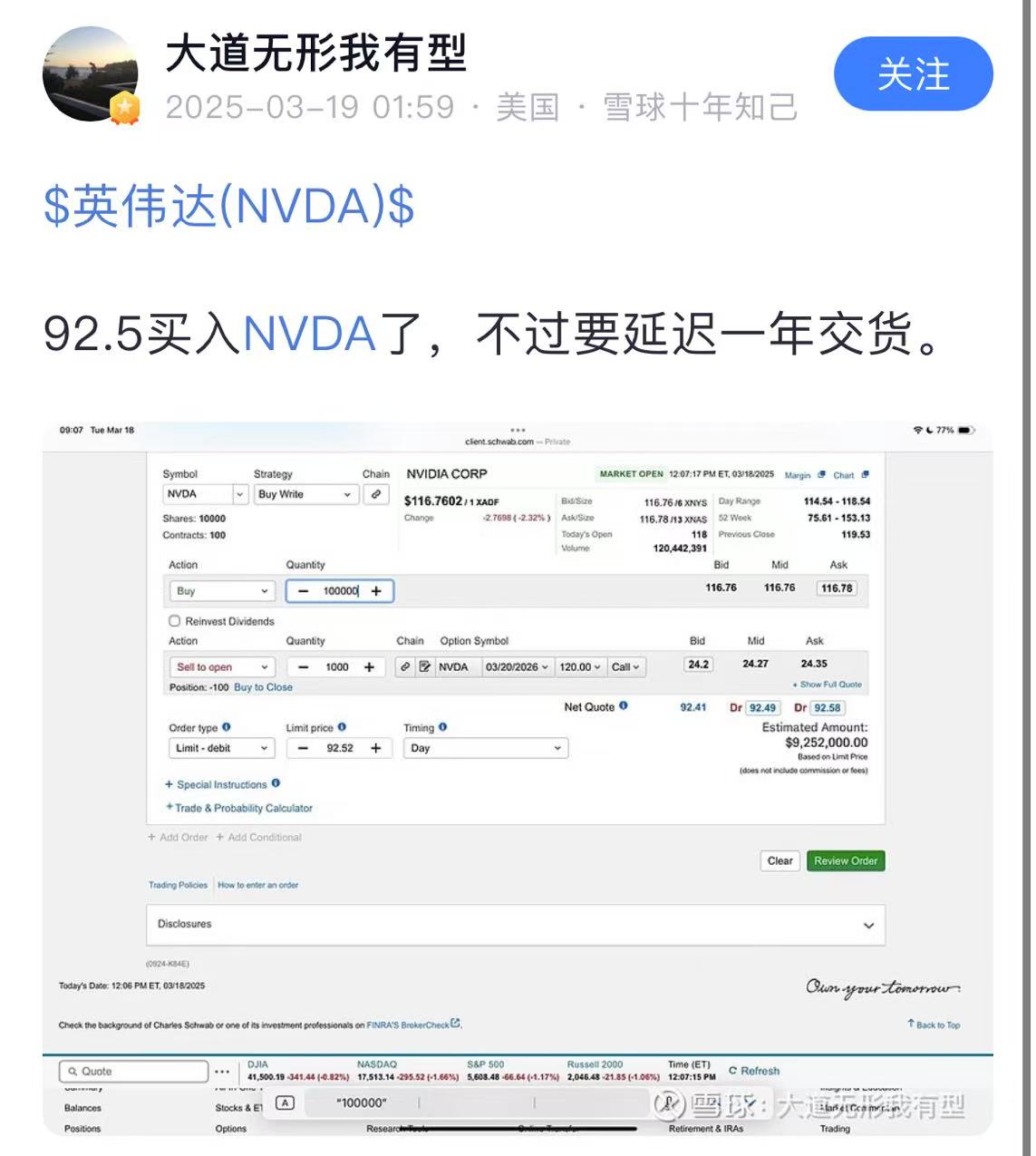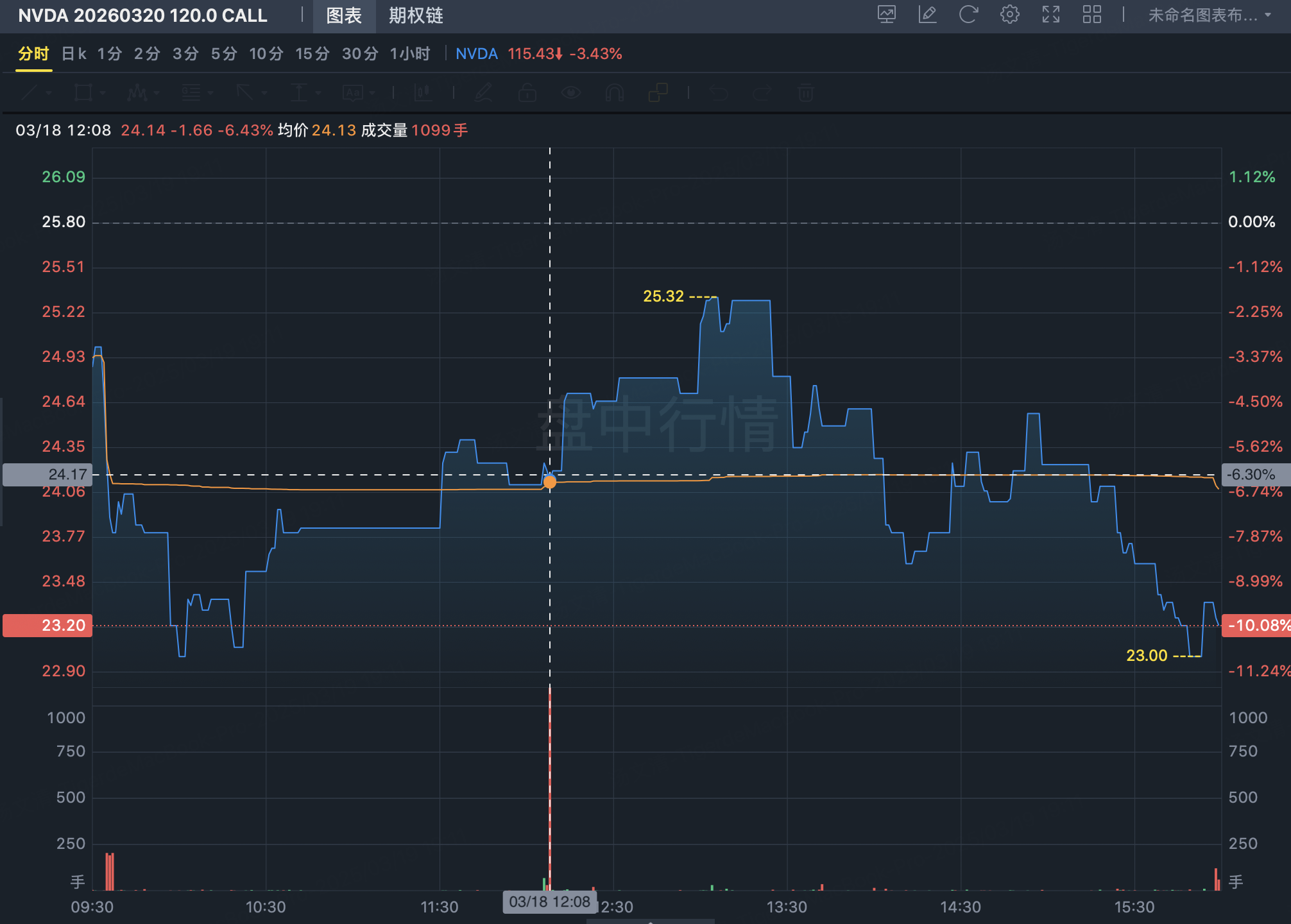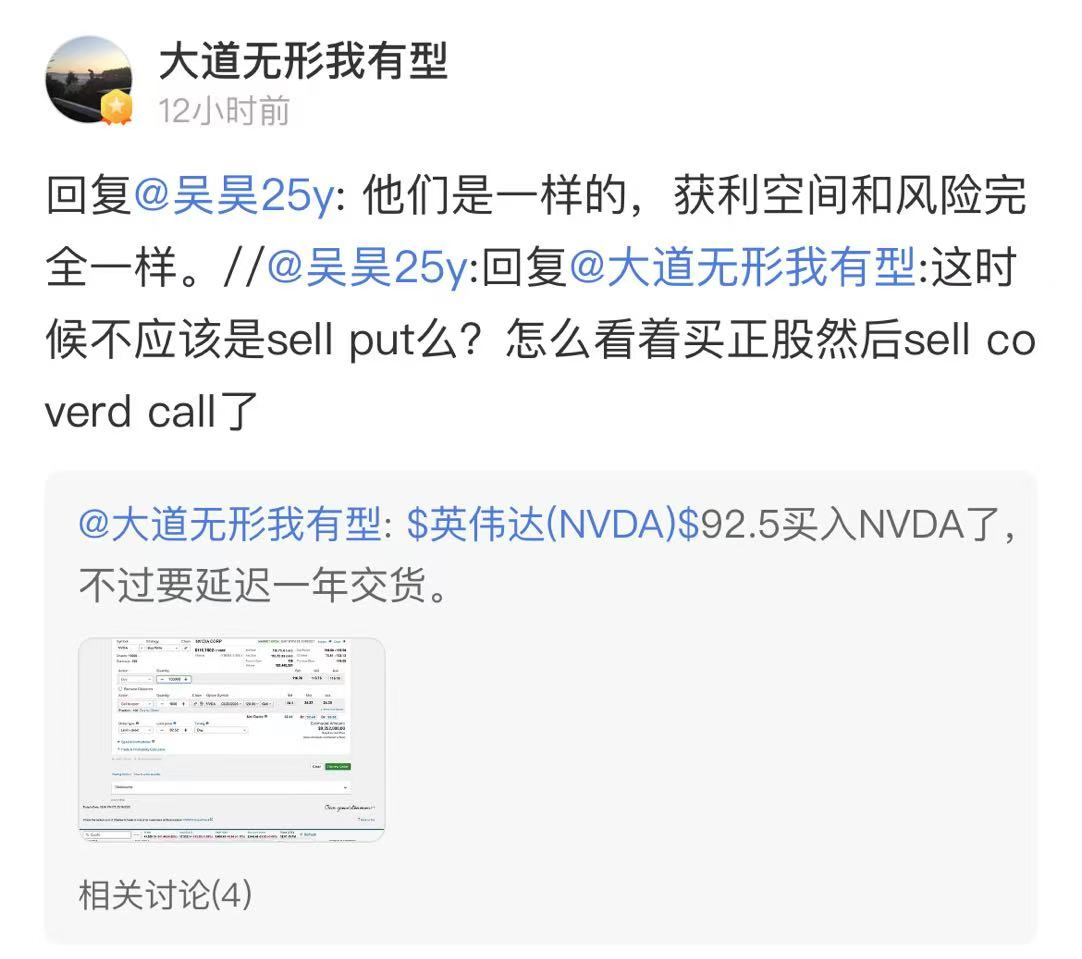Buy NVIDIA at 92.5 in a Year? Duan Yongping’s Trading Strategy Explained
Have you all seen Duan Yongping’s latest move? To summarize, the bad news is that NVIDIA’s expected price ceiling and floor have both been lowered; the good news is that the volatility range has become clearer, making it easier to profit from the swings.
Let’s analyze this trade in detail, take a look at NVIDIA’s forecast for this year, and discuss the corresponding strategies.
Leveraging the Shoulders of Giants
On March 19, renowned Chinese entrepreneur and investor Duan Yongping posted an update saying, “Bought NVIDIA at 92.5, but the delivery will be delayed by a year,” accompanied by a screenshot of the options transaction.
Let’s break down this options trade. First, the transaction occurred at 12:07 PM on March 18. Using Tiger Brokers’ PC options tool, this order can be tracked.
This trade consists of two actions:
First Action: Duan Yongping purchased 100,000 shares of NVIDIA stock at a price tilted towards the seller at $116.78.
Second Action: He sold to open 1,000 contracts of the $NVDA 20260320 120.0 CALL$ options, which expire on March 20, 2026, with a strike price of $120. Specifically:
Bought 100,000 shares of NVIDIA stock at $116.78 per share.
Sold 1,000 contracts of $NVDA 20260320 120.0 CALL$ .
The order also conveniently calculates the cost basis for holding the shares if the options are not exercised after a year, which equals $92.5 per share.
According to Tiger Brokers’ PC option screener, the $NVDA 20260320 120.0 CALL$ traded 975 contracts at 12:08 PM on March 18 at an average price of $24.14. The discrepancy from 1,000 contracts is due to large orders being filled in multiple transactions.
At 12:08 PM on March 18, the $NVDA 20260320 120.0 CALL$ had a total volume of 1,099 contracts with an average price of $24.13.
How Does This Trade Generate Profit?
If we assume Duan Yongping’s purchase price for NVIDIA was $116.5 and the option premium for $NVDA 20260320 120.0 CALL$ was $24, then the outcomes by March 2026 could look like this:
NVIDIA’s stock price is below $92.5:
Duan continues to hold the stock, but after subtracting the $24 premium, his cost basis drops to $92.5 per share, resulting in an unrealized loss.
NVIDIA’s stock price is above $92.5 but below $120:
Duan not only profits but also retains his shares. After subtracting the $24 premium, his cost basis remains $92.5 per share.
NVIDIA’s stock price is above $120:
Duan’s stock will be exercised and sold at $120, resulting in a profit of $24 (option premium) + ($120-$116.5), which totals $27.5. This is equivalent to selling the shares at $144.
NVIDIA’s stock price exceeds $144:
Duan gains the same as in scenario 3. The stock is exercised and sold at $120, with a total profit of $24 (premium) + $3.5 (share appreciation), or an equivalent sale price of $144.
Except for the first scenario, this strategy guarantees a profit in all other cases. Even in the first scenario, the loss is minimal, as NVIDIA’s growth trajectory makes it highly unlikely for the stock to stay below $92.5 for an extended period.
NVIDIA’s Price Outlook for This Year
From the above analysis, it’s clear that $92.5 and $144 are two critical price levels. The $120 strike price is important but less so.
If the strike price were adjusted to $130, the premium would drop to $20, and the cost basis after one year would become $96.5. In this case, any gains above $130 would effectively result in selling the stock at $150.
Choosing the $120 strike price essentially sets a defined upper and lower boundary for the stock. Duan Yongping believes buying NVIDIA at $92.5 is a good deal, and this strategy is equivalent to selling a $92.5 put option.
Most people in the community would likely agree that $92.5 is a bargain price for NVIDIA—it’s very attractive.
The critical question, then, lies in selling at $144.
If an investor believes selling NVIDIA at $144 a year from now isn’t a loss, it’s worth revisiting NVIDIA’s stock price forecast for this year.
Based on prior projections, NVIDIA had the potential to break through the $153 high and reach $160 or more. Institutional trades, such as butterfly spreads, placed over the past two weeks also suggest expectations of NVIDIA reaching $165, with a minimum target of $146.
Notably, a famous long-call trader, known as "200 Million Guy," has provided a more pessimistic price forecast of $120 for $NVDA 20250620 120.0 CALL$ in the first half of the year.
Selling at $144 doesn’t necessarily mean that $144 is the absolute maximum price this year. Extreme price levels could certainly exceed $144, with NVIDIA potentially reaching $150 or even $160. However, after reaching such highs, it might be prudent to reduce positions. High volatility this year is not without reason.
While expectations for the upper limit have been lowered, the clearer range is a positive development. Whether selling puts or calls, there’s now more confidence in the boundaries.
On Strategy Adjustments
Some savvy traders may wonder: since the forecast includes $144, should I consider buying a call option with a $144 strike price expiring in a year?
This is a common question. For example:
Can selling puts be replaced with buying calls?
Can selling calls be converted into buying puts?
Can buying shares outright be substituted with buying out-of-the-money calls?
These types of leverage conversions are common among both beginners and veterans. However, beginners often make riskier choices, such as selecting deeply out-of-the-money strike prices, which can lead to significant losses if the market trends sideways or volatility drops. In such cases, option sellers still profit, whereas buyers suffer heavy losses.
For Duan Yongping’s strategy, my suggestion is simple: just copy it. His order specifically mentioned that a covered call can be equivalently converted into selling a put option. While there’s no $92.5 strike put available, one could consider selling the $NVDA 20260320 90.0 PUT$ or $NVDA 20260320 95.0 PUT$ for an annualized return of around 10%.
This year’s market is clearly designed to shake out retail investors. For those who don’t want to actively trade, selling puts and staying passive is a solid strategy.
For active traders, the range between $92.5 and $144 is well-defined. Avoid greed, and this year could still yield substantial returns.
Disclaimer: Investing carries risk. This is not financial advice. The above content should not be regarded as an offer, recommendation, or solicitation on acquiring or disposing of any financial products, any associated discussions, comments, or posts by author or other users should not be considered as such either. It is solely for general information purpose only, which does not consider your own investment objectives, financial situations or needs. TTM assumes no responsibility or warranty for the accuracy and completeness of the information, investors should do their own research and may seek professional advice before investing.









Great article. Same logic can be applied to other shares as long as you see some good upside and little downside, then sell the covered call when IV is high.
Great article, would you like to share it?